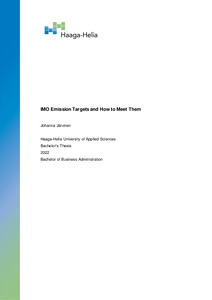IMO Emission Targets and How to Meet Them
Järvinen, Johanna (2022)
Järvinen, Johanna
2022
All rights reserved. This publication is copyrighted. You may download, display and print it for Your own personal use. Commercial use is prohibited.
Julkaisun pysyvä osoite on
https://urn.fi/URN:NBN:fi:amk-2022120326100
https://urn.fi/URN:NBN:fi:amk-2022120326100
Tiivistelmä
Shipping industry is facing drastic changes in the upcoming decades as International Maritime Organisation, or IMO for short, has set goals for the whole industry to cut down greenhouse gas emissions by 50% by year 2050. This requires amendments in used fuels, vessels and even modifying the whole infrastructure. This thesis went through possibilities in this field, such as what could be seen in the future as a solution and what actions have already been taken to address the issues.
This research was conducted as theoretical research as it aimed to understand and find out possibilities to lower emission levels. Data was collected through secondary data as the author based her suggestions on existing, already published literature such as books, and articles. Sources like IMO’s websites and logistics books the likes of Alan McKinnon’s Decarbonizing Logistics benefitted the author considerably as they provided a strong understanding of the field and its current status. Because this thesis concentrated on understanding shipping sector and its problems, qualitative research was the choice of research as results cannot be measured through numbers. For a reader to understand the topic better, key concepts are explained in the beginning. These include for example the concept of maritime transportation in general, greenhouses gases, International Maritime Organisation, or IMO, and its future targets.
In order to reach IMO’s goals, emissions need to be decreased to half of the. Solutions for this consist of using alternative fuels, increasing vessel sizes, and utilising slow steaming which means decreasing speed of a vessel. Alternative fuels on the other hand include usage of renewable energy sources, such as solar and wind power, natural gas, and hydrogen.
Results of this thesis suggest that there are several options to help tackle climate change and rising emission levels. Some of them are more ready to be used in vessels in a shorter timeframe due to already existing technology like in the case of renewable energy. Bigger infrastructural changes are required to gain full advantage for example from larger vessels.
This research was conducted as theoretical research as it aimed to understand and find out possibilities to lower emission levels. Data was collected through secondary data as the author based her suggestions on existing, already published literature such as books, and articles. Sources like IMO’s websites and logistics books the likes of Alan McKinnon’s Decarbonizing Logistics benefitted the author considerably as they provided a strong understanding of the field and its current status. Because this thesis concentrated on understanding shipping sector and its problems, qualitative research was the choice of research as results cannot be measured through numbers. For a reader to understand the topic better, key concepts are explained in the beginning. These include for example the concept of maritime transportation in general, greenhouses gases, International Maritime Organisation, or IMO, and its future targets.
In order to reach IMO’s goals, emissions need to be decreased to half of the. Solutions for this consist of using alternative fuels, increasing vessel sizes, and utilising slow steaming which means decreasing speed of a vessel. Alternative fuels on the other hand include usage of renewable energy sources, such as solar and wind power, natural gas, and hydrogen.
Results of this thesis suggest that there are several options to help tackle climate change and rising emission levels. Some of them are more ready to be used in vessels in a shorter timeframe due to already existing technology like in the case of renewable energy. Bigger infrastructural changes are required to gain full advantage for example from larger vessels.
